Beware ! You're in Kamikazie here. Not many pro luthiers around, more often brave souls experimenting in their kitchen.Neck straightening techniques
Straightening by heat
This article by Paco (aka 'Snap'), is archived from a discussion in the European Guitars Forum. You may want to read the original thread, with full discussion with other members.
One of the major (often found) problems on vintage guitars are deformed necks. These can be bowed, having a bump on the fretboard at the neck joint area, a twisted neck, raised fretboard extensions...
About a couple of years ago I was thinking that bowed necks on vintage guitars were an almost irreversible fault without a major surgery. That surgery may involve peeling the fretboard to get a new flat surface if the fretboard is thick enough, or removing the fretboard, replaning the entire neck and replacing the fretboard for a new one in the worst cases, or even replacing the full neck. At least this is what my trusty luthier always said to me. He's a very good one, but he has some weird ideas and concepts. Some folks say that the only solution is installing a new double action truss rod and/or carbon fiber rods as additional reinforcements while clamping the neck straight.
This was also my point of view until a couple of years ago as I said before. An old canadian fellow who was working as a repairman at a french luthier workshop for some years, laughed about all this and told me about a method he used a myriad of times for straightening old bowed necks. He said it worked every time. He explained me the procedure and I started looking for info all over the net, asking at lutherie forums, etc... This technique has some detractors (what in the world has no detractors!) but most folks out there, top builders and repairmen included, agreed that this is the method they use in most cases. So why not trying it?
Basically, it consists in clamping the neck straight and applying heat. Supposedly, there are two process going on here. One is pressure and heat applied to the wood itself, and the second one is heat applied to the glue. Pressure and heat were always used to bend wood, just think about bending the sides of a guitar to shape, or pressing backs and tops for archtops (solid or laminated) to get a desired shape or arching. They don't recover the original shape easily. Maybe they fail after many years under (cold) pressure, but this doesn't happen so often. Most detractors of this technique support that necks won't remain straight after the repair and will be back to the previous bent shape shortly. They argument that wood has "memory".
The second process going on is softening the glue somewhat when applying heat. The pressure applied will make the fretboard and the neck to slightly shift and realign. Once we remove heat and let these two parts cold up forced to be straight they will remain straight. Detractors assure this is not possible. The pressure won't allow the wood to shift and they doubt the glue softens enough to allow them to shift anyway.
Well, I don't know what really happens. Whether both things happening together or only one of these two... or anything else, but the truth is that it works. I guess detractors never had the guts to try it or did it wrong and ruined a guitar neck or... who knows.
Let's go into the process. First the tools.
This is what I use:
LMI neck heater
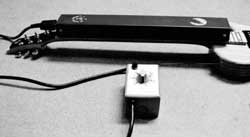
Stew-Mac 24" Fret/Fingerboard leveler
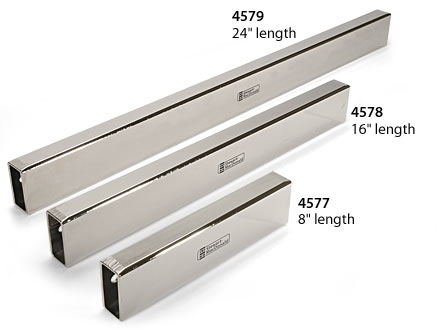
Sadly the LMI neck heater is discontinued. It seems that the poor sales of this thingy pushed these guys to drop it from the catalog. It was still available a few weeks ago... Stew-Mac used to have one too, but also discontinued about two years ago. There is still one currently available from Aria (picture below), but incredibly expensive. I asked about getting one to the Spanish Aria distributors a couple of years ago. They replied that it will take about six to nine months to arrive and would cost about 500€ plus taxes payed in advance! I went for the Stew-mac but it was already discontinued, so I finally got the LMI for half the price of the Aria thing.
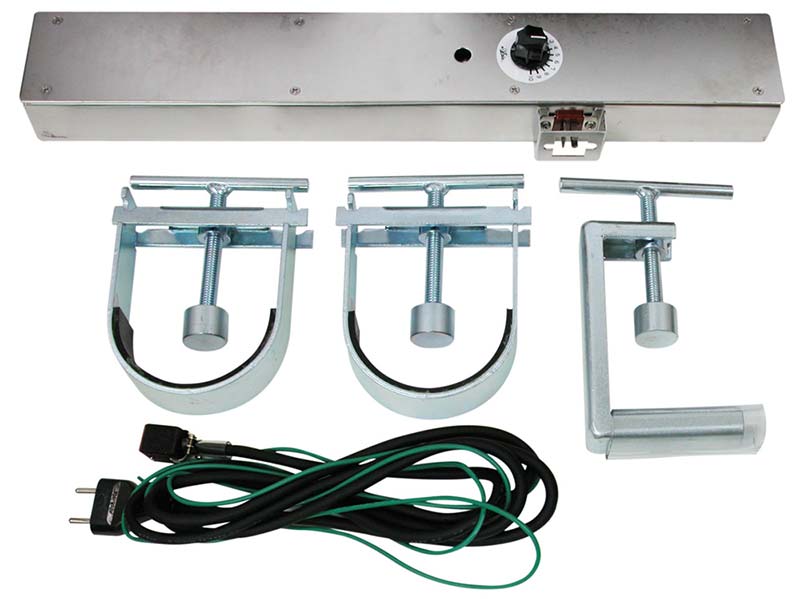
Thankfully, LMI still offers their good repair blankets. There is a long one (SPBL4220) intended for fretboard removal that should work good placed in-between the Stew-Mac leveler and the fretboard.
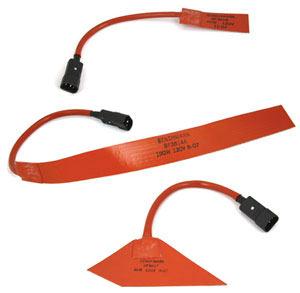
PS, read the Aria Neck Straightener instructions and pictures in the Aria website, they are useful whatever heater you use.
This is the way I do it.
First I inspect the necks to evaluate the bow or the way it is deformed to decide where to place the clamps. I provisionally mark the spots with masking tape or a simple pencil mark. If a guitar has a truss rod, always completely loosen the nut before proceeding.
Here are two examples of not very beautifully bowed necks. First a (typically Otwin) abrupt bow in the upper frets area while the rest remains straight enforcing a very high action with no solution besides bridge height adjustment. I've seen this same fault in a few beech necked Otwin archtops. The second one is a twisted Monarch neck. Both turned out good after the torture.

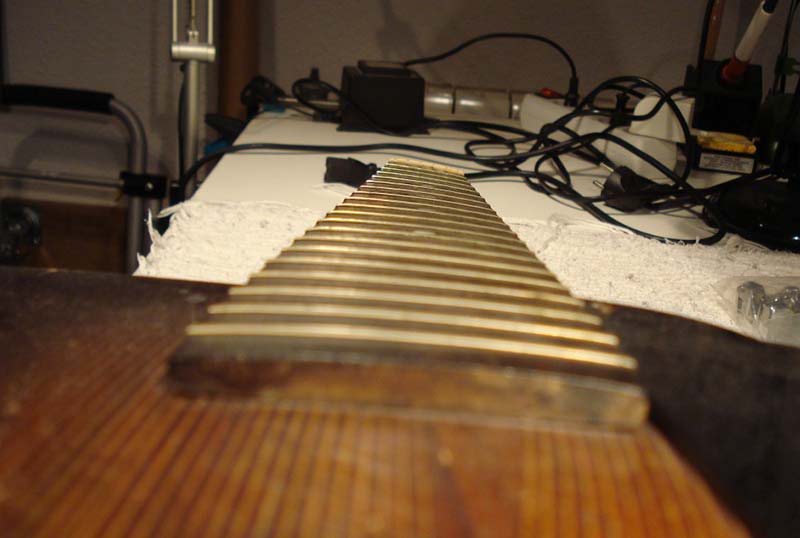
Once I decide where to clamp, I make a few cauls and cork pads that will be placed in between the clamp jaws and the neck or the straightener/leveler. In my early attempts I used a two component car repair putty to make the cauls. This stuff gets very hard and can be molded to perfectly fit the neck profile shape.
Here are the preparatory steps: Making the cauls.
- Mix the two putty components together until I get an homogenous paste.
- Then, to protect the finishing, I place a thin non adherent plastic foil or sulphurized paper over the neck. If you are not completely sure that a given plastic foil is not adherent under heat, better use sulphurized paper. It never fails.
- Spread the putty over the protective foil.
- Put a cork pad on top of the putty making sure if well seated and flat and allow the putty to get hardened.

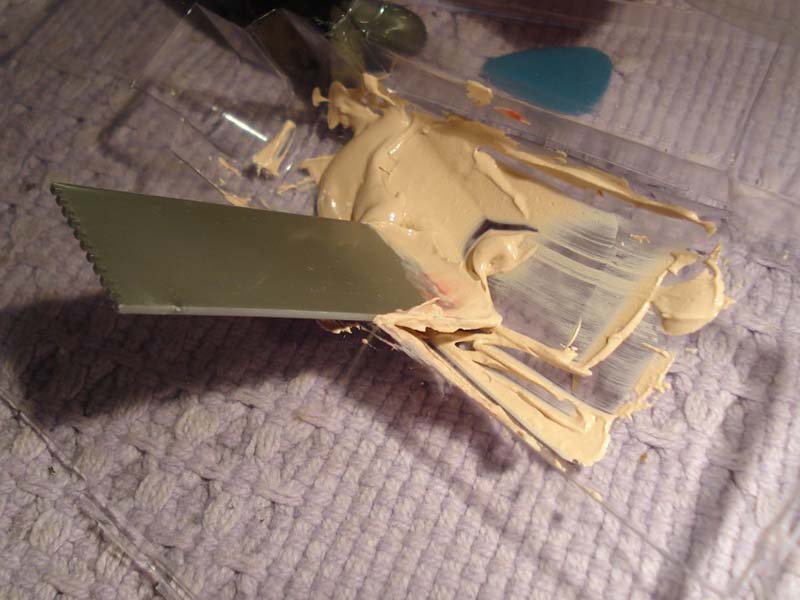
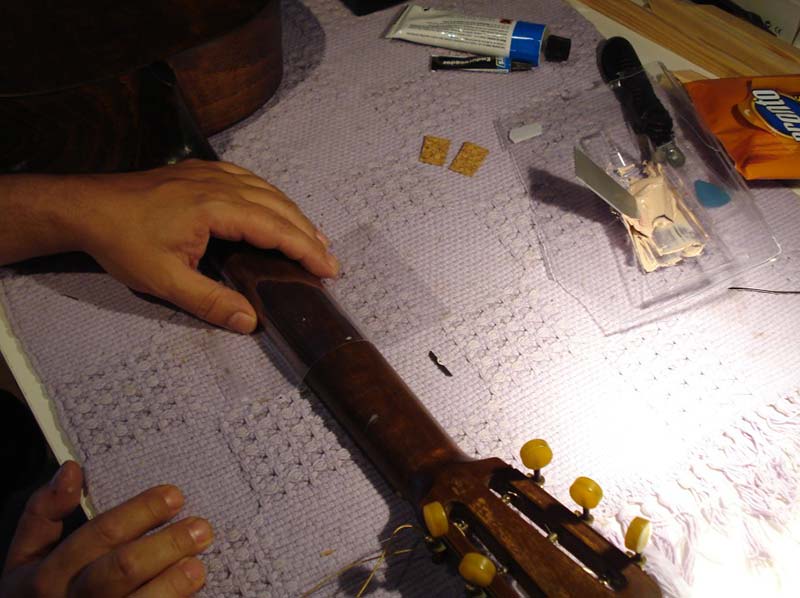
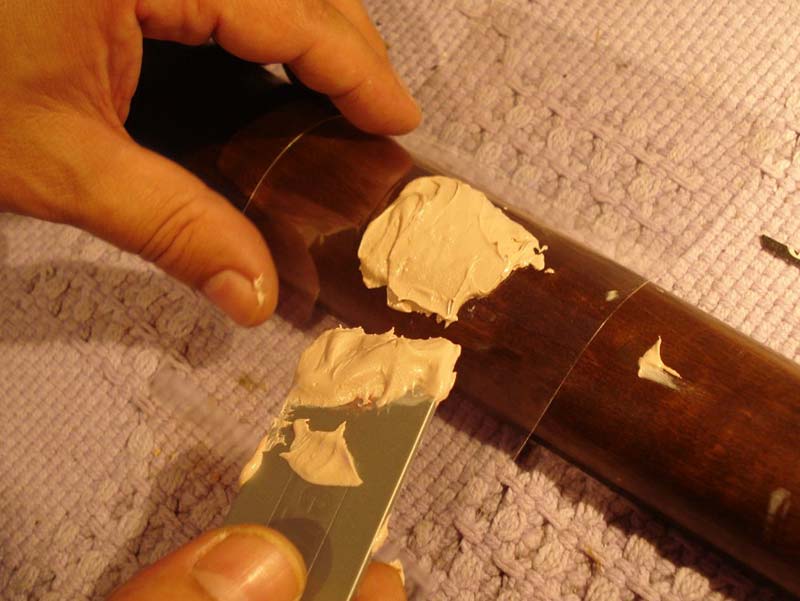
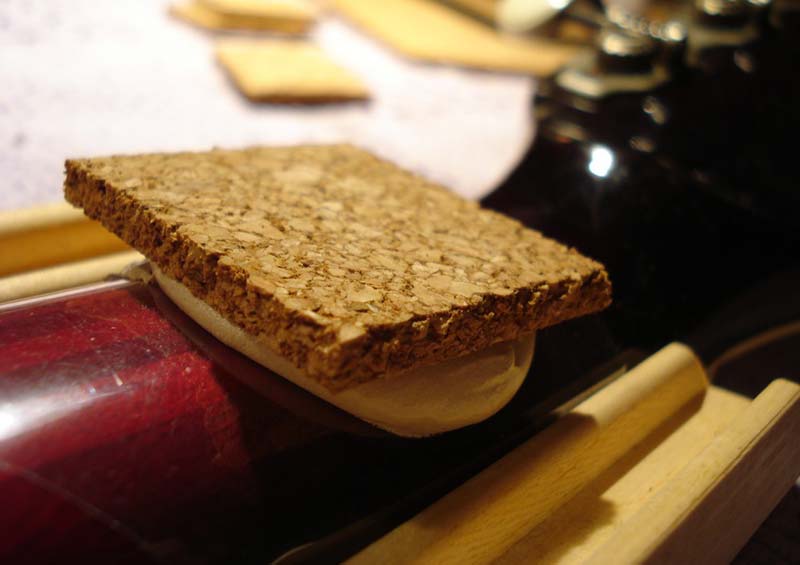
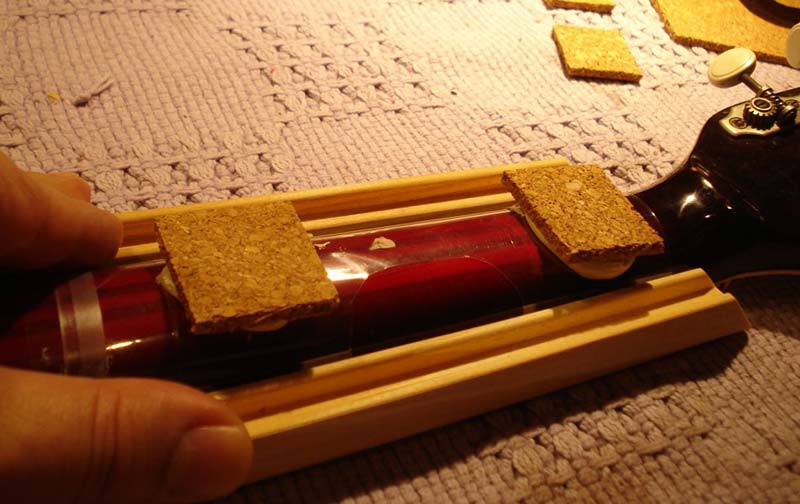
Here are the cauls ready to work. They match the neck profile so they won't slip when clamping.
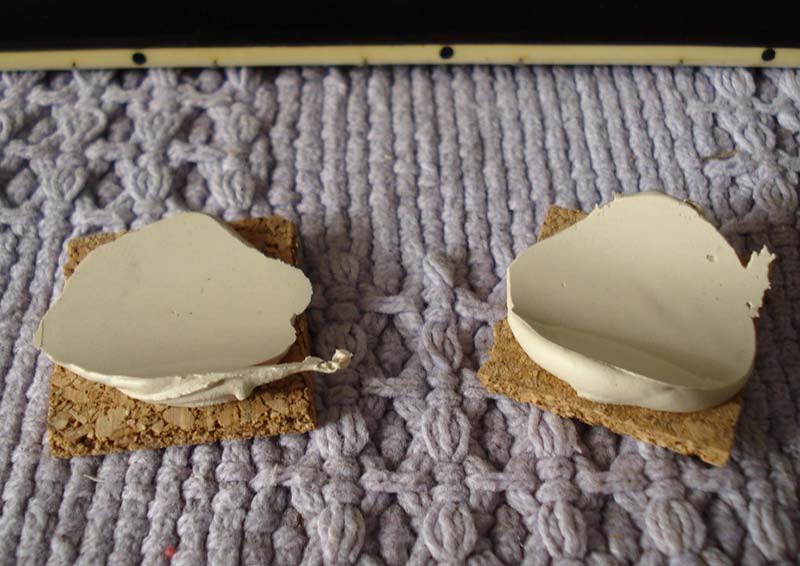
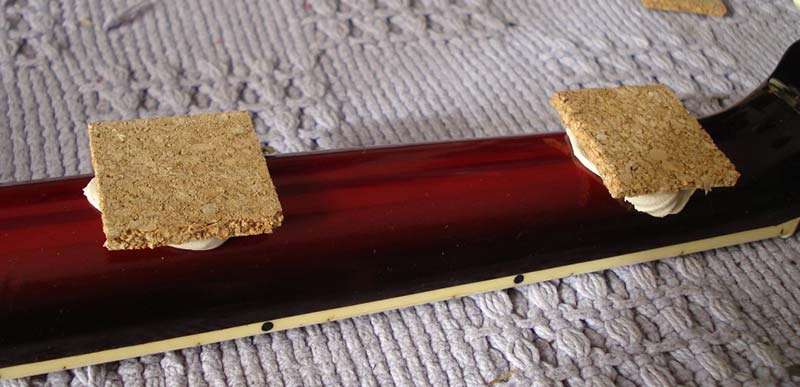
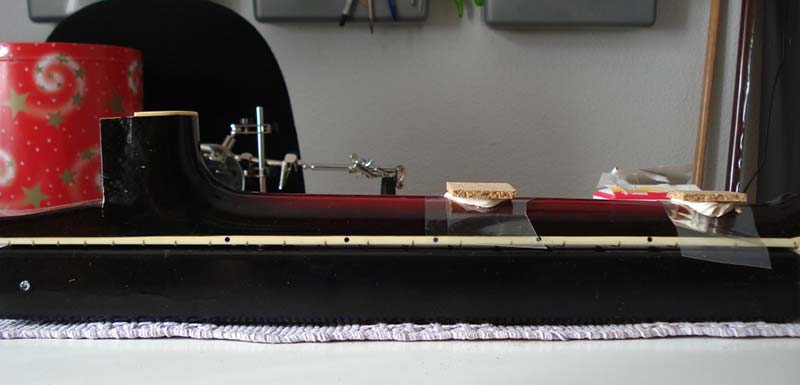
Time to get the heater in place centering the neck as good as possible. It is bowed, eh? Frets are far from touching the heater.
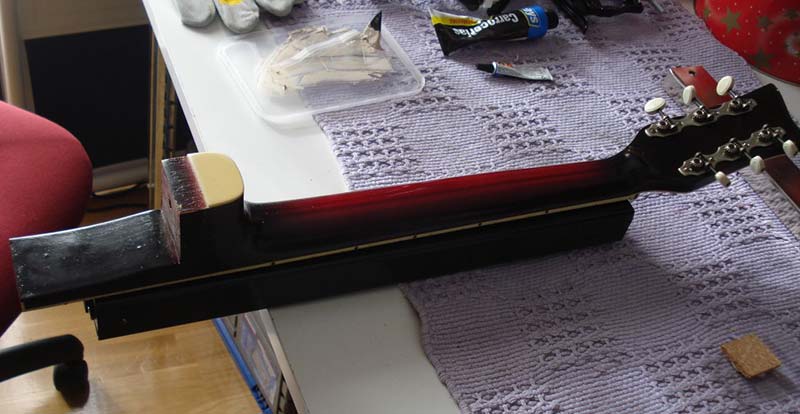
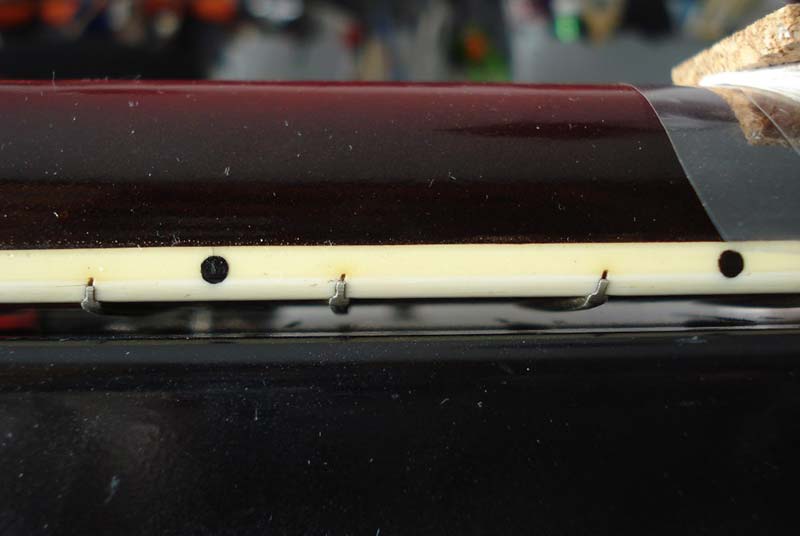
Start clamping. I like to clamp the heel first, specially for set necks (glued-on). This makes the whole thing easier to handle, the heater plus the guitar and the clamps weight a ton! Then go for the nut area clamping and finally the rest of the clamps going in-between these two. One or two more clamps may be needed depending on particular neck bows.



Sometimes I use three clamps.
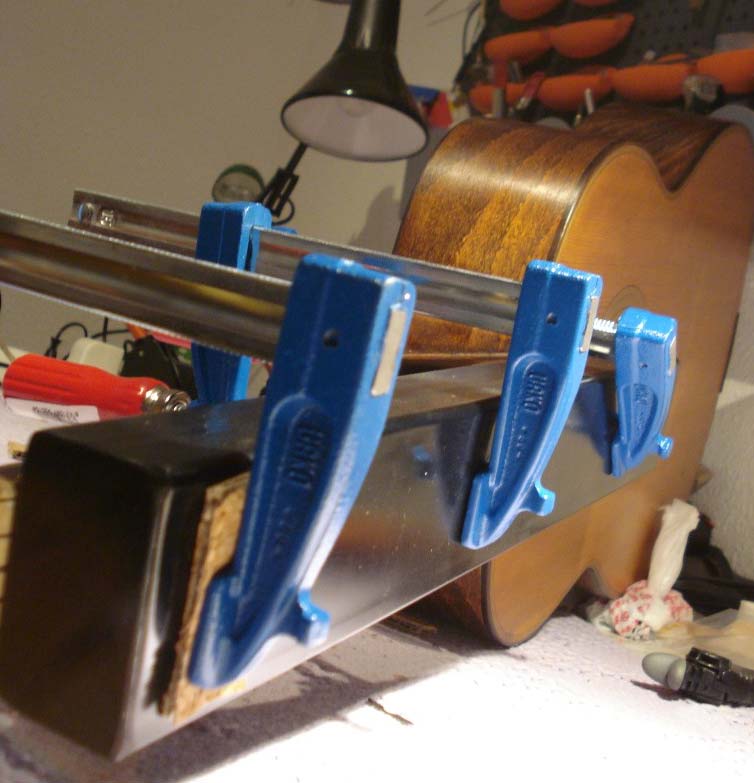

But some necks may need more clamping to get them even by using four clamps, specially those very stiff, very bowed or twisted. And in certain occasions raised tongues (fretboard extensions) may need further attention.

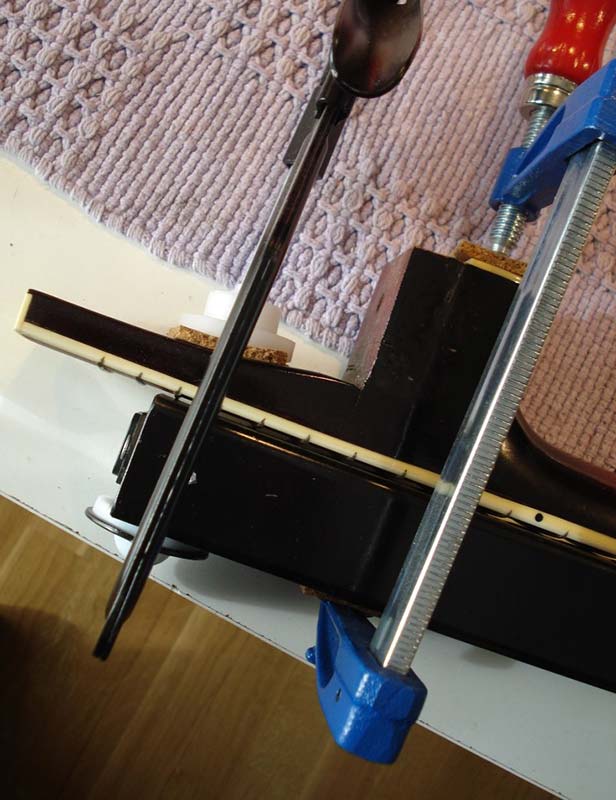

Don't forget to pay special attention to the other side of the heater/leveler to get the clamp jaws well centered. We don't want twisting forces here. It very easy to get the clamps misaligned at this side, so take care when placing and tightening them.

Time to tighten the clamps. I always tighten the clamps hard, but don't overkill! We don't want to break anything. I was concerned after a few attempts about deforming the fret crowns if tightening the whole thing too much, so I tried a couple of guitars at once getting the frets just touching the straightener. It didn't worked in any of both cases and I needed to redo the whole process. So don't get afraid about that. I never deformed the frets, and if it ever happens I think it worths a fret dressing after the procedure than failing to get the necks straight.
Ok, we get it ready, now let's apply heat. Depending on the neck woods and neck thickness it will take from fifteen to twenty some minutes to get it properly warm. after 7 or 8 minutes I start to check the neck back temperature regularly. I let it warm up until it feels nicely warm. Not very hot or mildly warm, just warm-hotish when you touch it. (sorry, never measured the temperature). Once reached this condition get your gloves, remove the clamps and carefully get the heater apart and replace it by the leveling bar. Then clamp it tight and carefully again. Be fast but don't rush things up and have a place to leave the heater, it's very hot at this moment. Once you get the neck clamped again let it cool slowly. Wait at least 24 hours to remove the clamps.
When necks are very bowed or are very stiff, I sometimes leave it alone for two or three days and sometimes I even apply heat once every day too. It's not a bad idea to protect plastic inlays, plastic nuts or string spacers and celluloid bindings to prevent they would eventually melt and deform, though I've never melt anything until now.
Check these pictures. The heater was replaced by the cold leveler. I haven't pics of this part of the process, because I go fast and never stopped to shot pics. I'm always nervous at this moment trying to not burning my hands or anything else when leaving the heater over there.
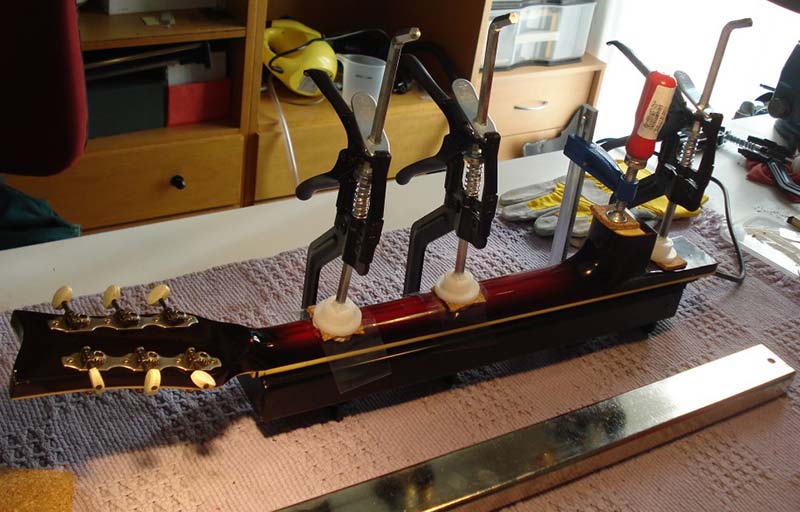
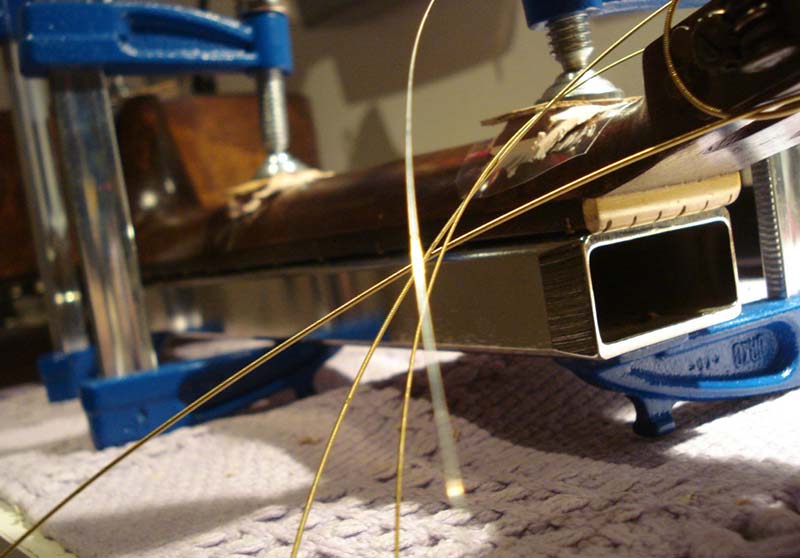
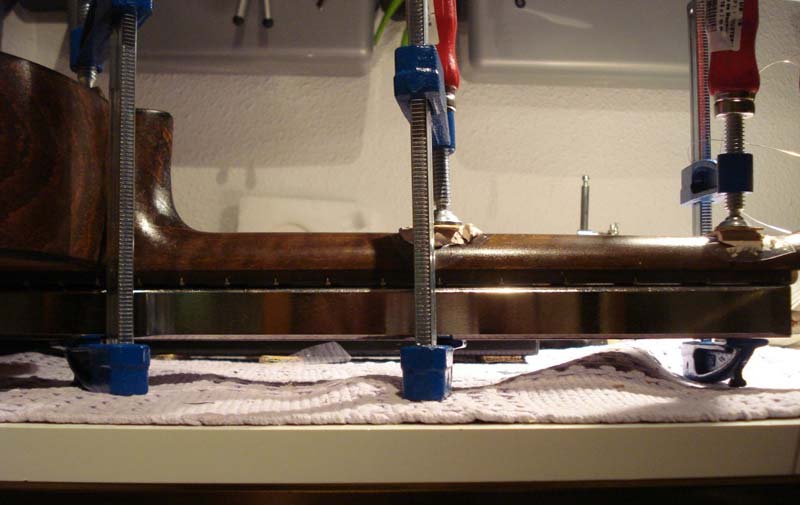
Let it cool down.
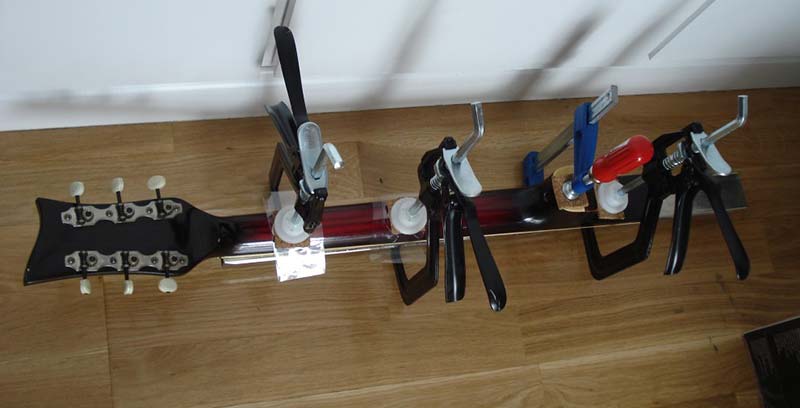
With ebony fretboards, have special caution when heating. Use a lower temperature and let some more time to get the neck warm. Ebony have a nasty tendency to crack when loosing its oils by heating. This happens often to old dry guitars too. So be very careful and always use some fretboard oil on ebony before performing this technique. If a fretboard looks dry I always use lemon oil before whatever wood it is. But for ebony I allow to get a proper hydration for some days before the straightening process. If necessary, I apply oil in two or three consecutive days and also after the process.
I'd like to talk about a new stuff I'm currently using instead of the dangerous car repair putty. It is the great LMI Friendly Plastic. I badly love that stuff! It's incredibly useful to make impossible shaped cauls, or molds, or whatever very easily and on the fly.
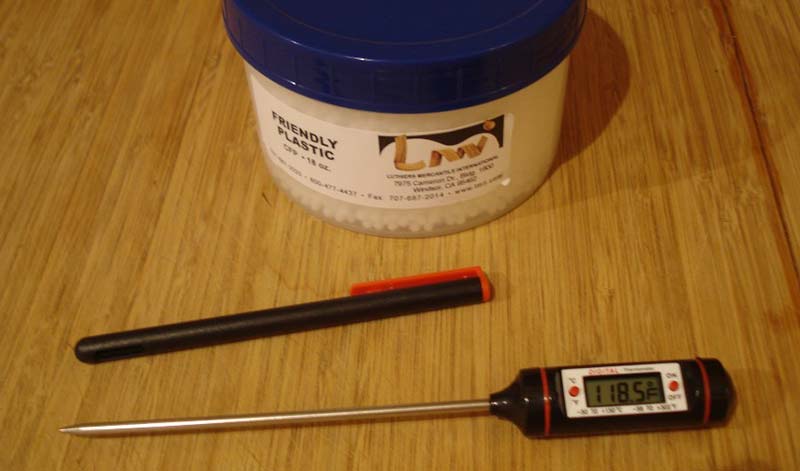
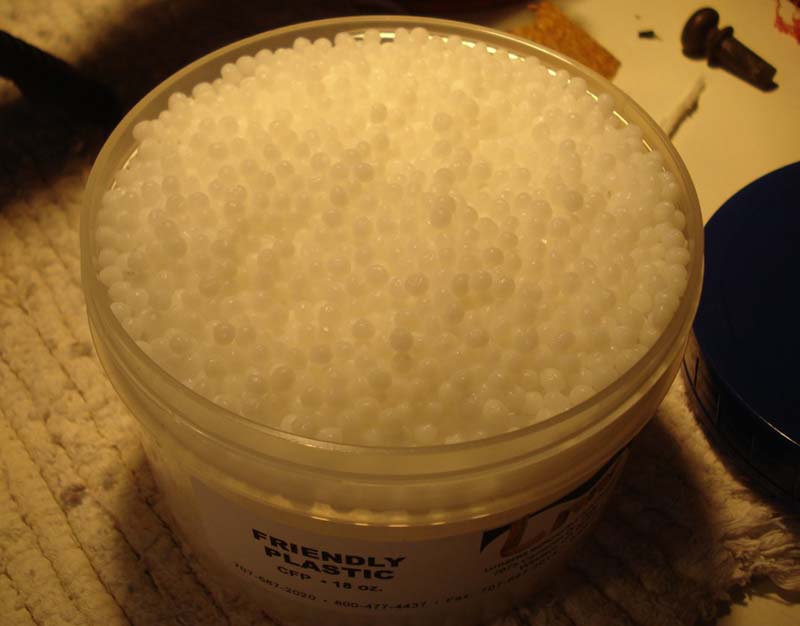
I made a few rookie mistakes the first time I used this stuff. Here are some cautions to get it right.
Never drop too much stuff into the pot. Never directly from the can and always spread it uniformly from your hand all over the pot bottom.
Allow a few minutes to get completely transparent. Then remove the water, grab and compact the stuff, it's not too hot to manipulate it right from the warming pot.
Allow it to cool down a bit but not too much so you still can mold it easily. Then proceed to place it over the sulphurized paper on top of the neck's back. You already know the rest.
These are pictures from my first Friendly plastic experience. Not very good, but I learned my lesson and did it right the next time.
Too much stuff, too little patience. The stuff is still too white and not fully transparent, some beads did not melt... wrong!
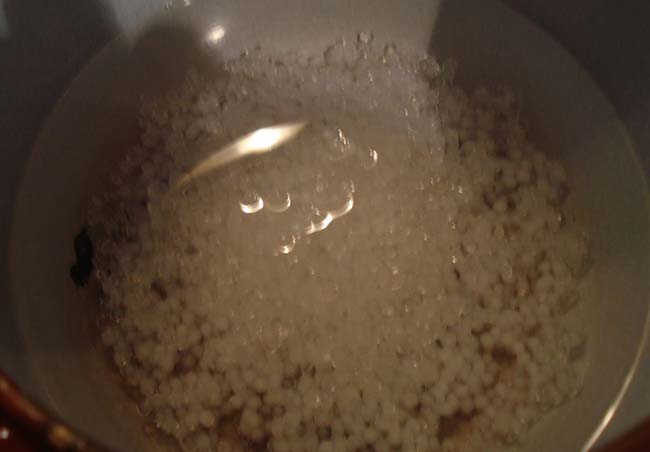
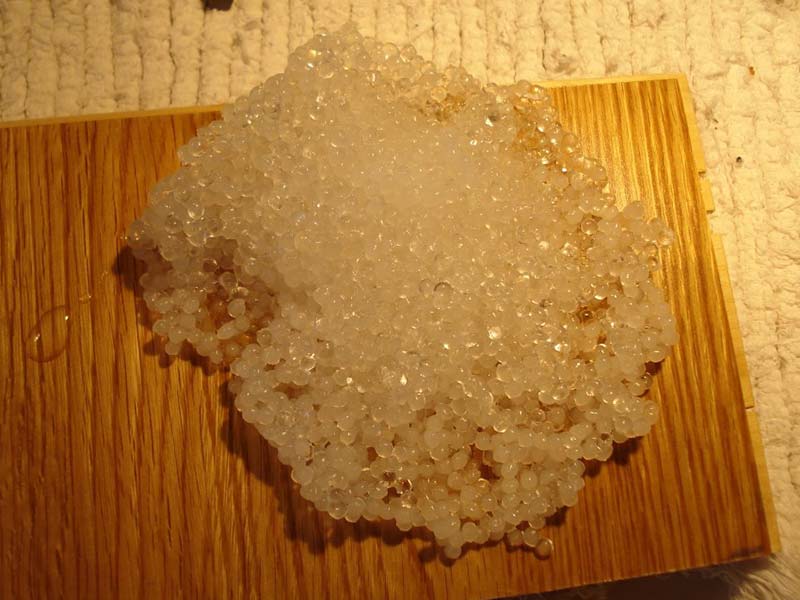
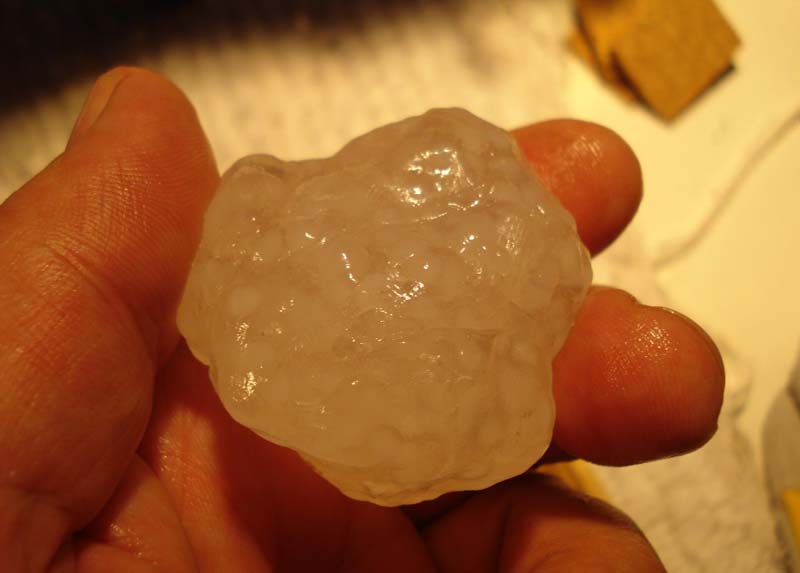
I got the stuff directly over the neck... wrong! This stuff is not sticky, well, when cool is not sticky at all, but it gets sticky when warm. So never skip putting a protective foil underneath. I did it and messed up the lacquer on one of my wife's guitars... she almost killed me! :?
Then I made the upper surface flat with a small flat board. No need for cork pads or anything else. But the stuff was not fully melt so the top surface resulted a bit uneven. I had to redo the cauls, but works great if done right.

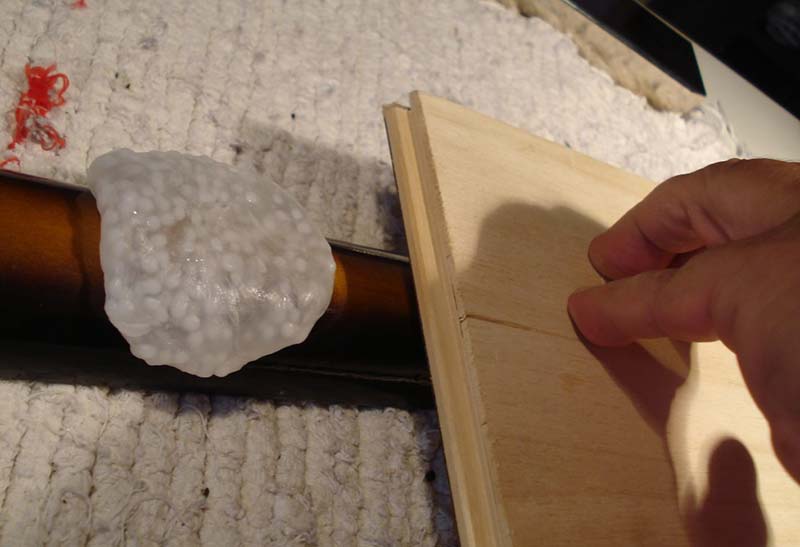
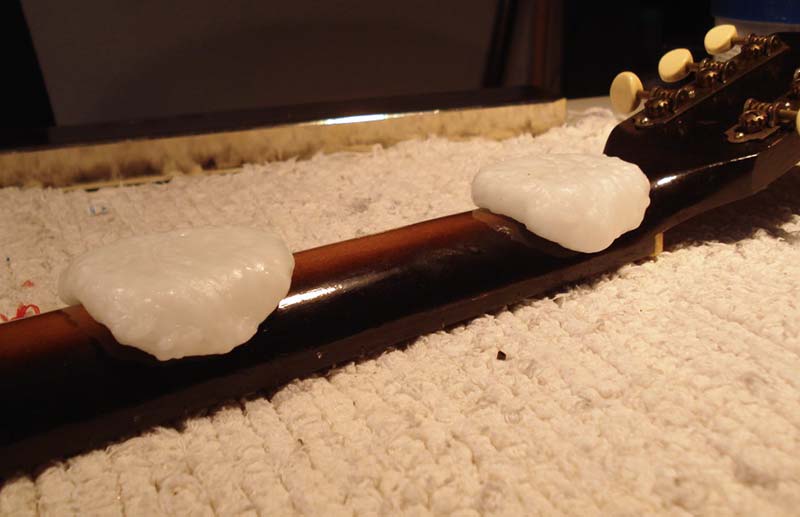
Hope you find this useful.
There is one more straightening technique. It's the compression refreting. I've never did it until now. I'll experiment with a few necks I have around before going to one or two crappy guitars. This technique involves some previous learning to do it right, so I'll tell you about whenever I get some successful experiences... but don't hesitate to teach us how to do it if any of you already has some skill with it.
Snap
august 2009
back to Kamikazie Lutherie Index |


